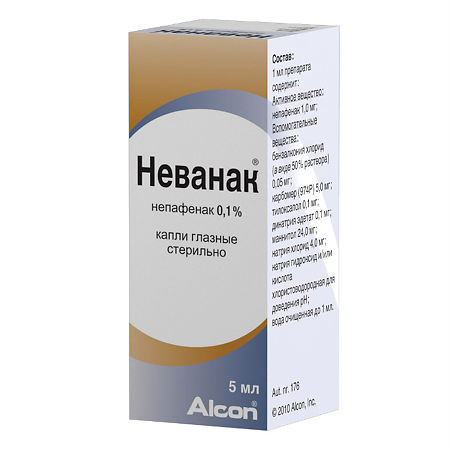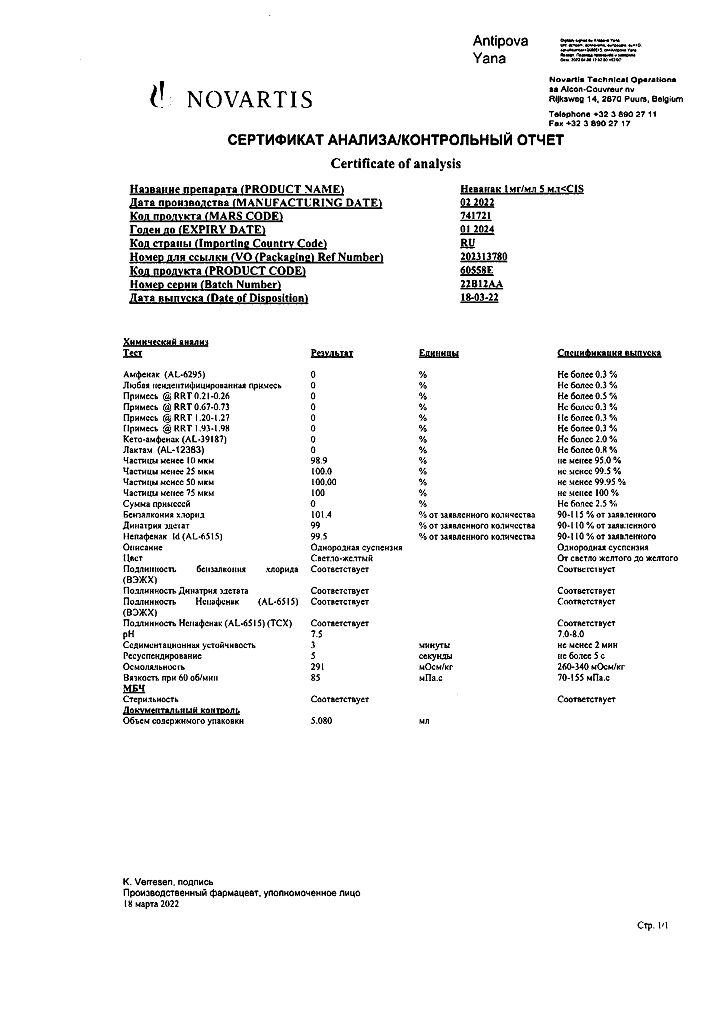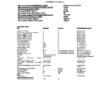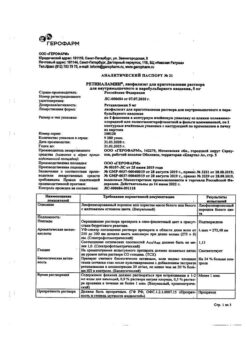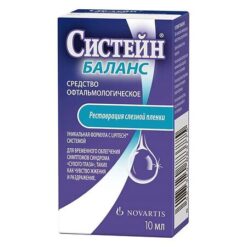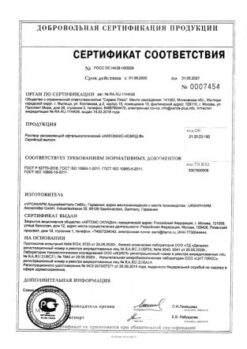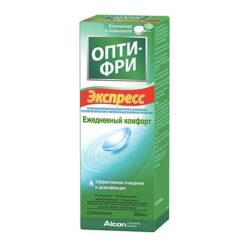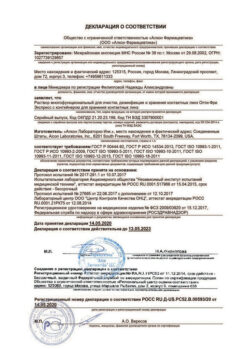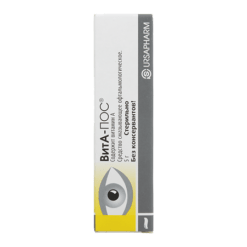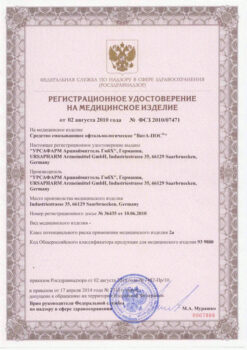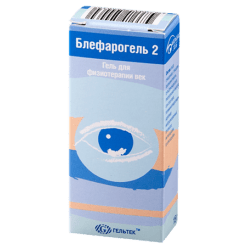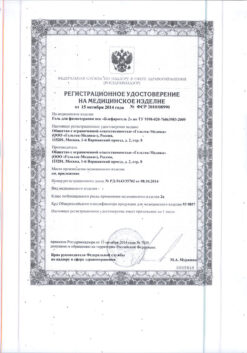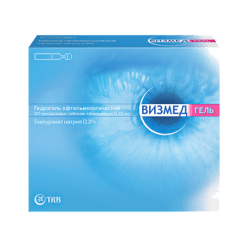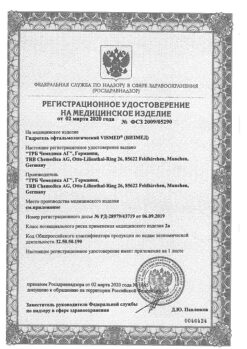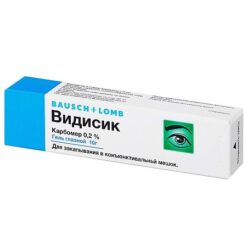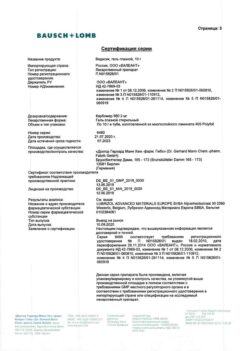No products in the cart.
Nevanac, eye drops 0.1% 5 ml
€26.24 €21.86
Description
Nepafenac is a precursor of the active form of non-steroidal anti-inflammatory drugs with analgesic and anti-inflammatory effects, it penetrates the cornea of the eye where it is converted by hydrolases into amphenac, the active form. Amphenac inhibits the action of cyclooxygenase (prostaglandin-N synthase), an enzyme necessary for the production of prostaglandins.
When used topically, nepafenac reduces ocular swelling and pain, and has no significant effect on intraocular pressure.
Pharmacokinetics
Absorption
Nevanac is rapidly absorbed through the cornea. Three daily injections of Nevanac in both eyes revealed low measurable plasma concentrations of nepafenac and amphenac after 2 and 3 h, respectively. The Cmax of nepafenac in plasma after topical application was 0.310±0.104 ng/mL; the Cmax of amphenac was 0.422±0.121 ng/mL.
The average Cmax of nepafenac in aqueous humor is observed after 1 hour.
Distribution
Amphenac has a high affinity for serum albumin. In vitro binding to rat albumin, human albumin and human serum was 98.4%, 95.4% and 99.1%, respectively.
Rat studies have shown that radioactively labeled substances bound to the active ingredient are widely distributed in the body after single and multiple oral doses of 14C-nepafenac.
Metabolism
Nepafenac undergoes rapid hydrolysis to amphenac under the action of intraocular hydrolases when administered topically.
The further metabolism of amphenac proceeds by hydroxylation of the aromatic ring, which leads to the formation of conjugates with glucuronic acid. Radiochromatographic analysis performed before and after hydrolysis with P-glucuronidase showed that all metabolites were in the form of conjugates with glucuronic acid, except for amphenac. Amphenac was the major metabolite in plasma, accounting for about 13% of the total radioactivity detected in plasma. The second most common plasma metabolite was 5-hydroxynepafenac with 9% of total radioactivity at Cmax.
Excretion
Nepafenac is excreted primarily by the kidneys (about 85% of the radioactive label with oral administration of 14C-nepafenac is found in the urine, about 6% in the feces), but urinary concentrations of nepafenac and amphenac are not quantifiable.
Indications
Indications
Prevention and treatment:
Postoperative pain.
Inflammatory phenomena during surgical interventions for cataract removal.
Pharmacological effect
Pharmacological effect
Nepafenac is a precursor to the active form of non-steroidal anti-inflammatory drugs with analgesic and anti-inflammatory effects; it penetrates the cornea of the eye, where, with the help of hydrolases, it is converted into amfenac, the active form. Amfenac inhibits the action of cyclooxygenase (prostaglandin H-synthase), an enzyme necessary for the production of prostaglandins.
When applied topically, nepafenac reduces swelling of the eye tissue and pain, and does not have a significant effect on intraocular pressure.
Pharmacokinetics
Suction
Nevanac is rapidly absorbed through the cornea of the eye. When Nevanac was instilled three times daily into both eyes, low measurable concentrations of nepafenac and amfenac were detected in the blood plasma after 2 and 3 hours, respectively. Cmax of nepafenac in plasma after topical application is 0.310±0.104 ng/ml; Cmax of amphenac – 0.422 ±0.121 ng/ml.
The average Cmax of nepafenac in aqueous humor is observed after 1 hour.
Distribution
Amfenac has a high affinity for serum albumin. In vitro binding to rat albumin, human albumin and human serum was 98.4%, 95.4% and 99.1%, respectively.
Studies in rats have shown that radiolabeled substances associated with the active substance are widely distributed in the body after single and repeated oral doses of 14C-nepafenac.
Metabolism
When applied topically, under the action of intraocular hydrolases, nepafenac undergoes rapid hydrolysis to amfenac.
Further metabolism of amfenac occurs through hydroxylation of the aromatic ring, which leads to the formation of conjugates with glucuronic acid. Radiochromatographic analysis carried out before and after hydrolysis with the participation of P-glucuronidase showed that all metabolites were present in the form of conjugates with glucuronic acid, with the exception of amfenac. Amfenac was the main metabolite in plasma, accounting for approximately 13% of the total radioactivity detected in plasma. The second most abundant metabolite in plasma was 5-hydroxynepafenac, with 9% of total radioactivity at Cmax.
Removal
Nepafenac is excreted primarily by the kidneys (about 85% of the radioactive tracer after oral administration of 14C-nepafenac is found in urine, about 6% in feces), but the concentrations of nepafenac and amfenac in urine cannot be quantified.
Special instructions
Special instructions
When using Nevanac, patients should avoid sun exposure.
This product contains the preservative benzalkonium chloride, which may cause eye irritation and discoloration of soft contact lenses. Additionally, wearing contact lenses is not recommended during the postoperative period following cataract surgery. It is not recommended to use contact lenses during treatment with Nevanac.
Experience with topical NSAIDs suggests that patients with complications from ophthalmologic surgery, corneal denervation, corneal epithelial defects, diabetes mellitus, superficial ocular disease (eg, dry eye syndrome), rheumatoid arthritis, or repeated surgical procedures performed within a short period of time may have an increased risk of developing corneal adverse reactions, which may pose a risk of vision loss. Topical NSAIDs should be used with caution when treating these patients. Long-term use may increase the risk and severity of corneal adverse reactions.
The use of the drug, like other topical NSAIDs, can cause keratitis. Long-term use may increase the risk of occurrence or worsen the severity of adverse reactions of the cornea.
Use of the drug in combination with eye surgery can cause intense bleeding into the eye (including hyphema).
Nevanac should be administered with caution to patients with a history of bleeding or when patients are receiving other medications that increase blood clotting time.
The drug contains benzalkonium chloride, which can cause eye irritation and discoloration of soft contact lenses, so they are not used. In addition, the use of contact lenses is prohibited during the recovery period after cataract surgery.
Do not touch the dropper bottle to any surface to avoid contamination of the bottle and infection of its contents. The bottle must be tightly closed after each use.
Cross Sensitivity
When using nepafenac, there is a possibility of developing cross-sensitivity to acetylsalicylic acid, fennacetic acid derivatives, as well as other NSAIDs.
Impact on the ability to drive vehicles and operate machinery
After using Nevanak, a temporary decrease in visual acuity, as well as clarity of visual perception, is possible, therefore, until visual functions are fully restored, driving a car or engaging in activities that require an adequate reaction and increased attention is prohibited.
Active ingredient
Active ingredient
Nepafenac
Composition
Composition
Eye drops 0.1% in the form of a suspension from light yellow to light orange.
1 ml – nepafenac 1 mg
Excipients:
benzalkonium chloride (as a 50% solution) 0.05 mg,
carbomer 974R 5.0 mg,
tyloxapol 0.1 mg,
disodium edetate 0.1 mg,
mannitol 24.0 mg,
sodium chloride 4.0 mg,
sodium hydroxide and/or hydrochloric acid to adjust pH,
purified water to 1 ml.
Pregnancy
Pregnancy
Use during pregnancy and lactation is not recommended. If it is necessary to prescribe during lactation, it is recommended to stop breastfeeding for the duration of treatment.
Animal testing revealed reproductive toxicity. In a study of the effects of nepafenac on the reproductive organs of rats, administration of toxic doses >10 mg/kg led to dystocia, an increase in the number of spontaneous abortions at the post-implantation stage, a decrease in body weight and growth of embryos, and a decrease in embryo survival. In pregnant rabbits, taking low-toxic doses of 30 mg/kg led to an increase in developmental defects in the offspring.
Use in children
Contraindicated in children under 18 years of age.
Contraindications
Contraindications
Individual hypersensitivity to the components of the drug, as well as to other non-steroidal anti-inflammatory drugs.
Caused by taking acetylsalicylic acid or other non-steroidal anti-inflammatory drugs:
Bronchial asthma.
Hives.
Acute rhinitis.
Age up to 18 years (the safety and effectiveness of the drug in children have not been studied).
Side Effects
Side Effects
Punctate keratitis, eye pain or itching, blurred vision, dry conjunctiva, crusting along the eyelid margins, iritis, keratitis, choroidal effusion, corneal deposits, eye discharge, eye irritation, photophobia.
Allergic conjunctivitis, discomfort in the eyes, lacrimation, conjunctival hyperemia.
Headaches, dyspepsia, dry mouth, sinusitis, skin distensibility (dermatochalasis), hypersensitivity.
Ulcerative keratitis, pathologies of the corneal epithelium, damage to the cornea, inflammatory infiltrates of the anterior chamber of the eye, slowing of the healing process of the cornea, scar on the cornea, decreased visual acuity, clouding of the cornea.
If there are signs of damage to the cornea, the use of the drug is immediately discontinued, and the cornea is carefully examined, since from the experience of using non-steroidal anti-inflammatory drugs it is known that patients with complications after ophthalmic surgical interventions, as well as with defects of the corneal epithelium, corneal denervation, diabetes mellitus, superficial eye diseases (for example, dry eye syndrome), as well as rheumatoid arthritis or repeated surgical interventions, have a high risk of developing side effects from the cornea, which pose a threat of loss of visual function.
Interaction
Interaction
In in-vitro studies, neither; nepafenac nor amfenac do not inhibit the metabolic activity of human cytochrome P450 (isoenzyme CYP1A2, 2C9, 2C19, 2D6, 2E1 and 3A4) at concentrations up to 300 ng/ml. Therefore, when used simultaneously with other drugs, interaction involving cytochrome P450 isoenzymes is unlikely. Interactions mediated by binding to plasma proteins are also unlikely.
There are no data on the simultaneous use of Nevanac and prostaglandin analogues. Given their mechanisms of action, simultaneous use is not recommended.
If necessary, it can be used in combination with other ophthalmic drugs for topical use. In this case, the interval between their use should be at least 5 minutes.
Overdose
Overdose
There are no data on drug overdose.
If excess amounts of the drug get into your eyes, it is recommended to rinse your eyes with warm water.
Storage conditions
Storage conditions
At 2–30 °C
Shelf life
Shelf life
2 years
Manufacturer
Manufacturer
Alcon-Couvreur, Belgium
Additional information
| Shelf life | 2 years |
|---|---|
| Conditions of storage | At 2-30 °C |
| Manufacturer | Alcon-Couvreur, Belgium |
| Medication form | eye drops |
| Brand | Alcon-Couvreur |
Related products
Buy Nevanac, eye drops 0.1% 5 ml with delivery to USA, UK, Europe and over 120 other countries.

